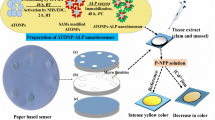Abstract
Dipicolinic acid (DPA) is an important chemical marker for the detection of bacterial spores. In this study, complexes of lanthanide series elements such as erbium, europium, neodymium, and terbium were prepared with pyrocatechol violet and effectively immobilized the pyrocatechol violet (PV)–metal complex on a filter paper using polyvinyl alcohol. These filter paper strips were employed for the onsite detection of bacterial spores. The test filter papers were evaluated quantitatively with different concentrations of DPA and spores of various bacteria. Among the four lanthanide ions, erbium displayed better sensitivity than the other ions. The limit of detection of this test for DPA was 60 μM and 5 × 106 spores. The effect of other non-spore-forming bacteria and interfering chemicals on the test strips was also evaluated. The non-spore-forming bacteria did not have considerable effect on the test strip whereas chemicals such as EDTA had significant effects on the test results. The present test is rapid and robust, capable of providing timely results for better judgement to save resources on unnecessary decontamination procedures during false alarms.







Similar content being viewed by others
References
Barnes LS, Kaneshige KR, Strong JS, Tan K, von Bremen HF, Mogul R (2011) Effects of terbium chelate structure on dipicolinate ligation and the detection of Bacillus spores. J Inorg Biochem 105:1580–1588
Cable ML, Kirby JP, Gray HB, Ponce A (2013) Enhancement of anion binding in lanthanide optical sensors. Acc Chem Res 46(11):2576–2584
Clear KJ, Stroud S, Smith BD (2013) Dual colorimetric and luminescent assay for dipicolinate, a biomarker of bacterial spores. Analyst 138:7079–7082
Curiel D, Sanchez G, Mas-Montoya M, Tárragaa A, Molinaa P (2012) Rational design of a fluorescent receptor for the recognition of anthrax dipicolinate. Analyst 137:5499–5501
Dybwad M, Laaken AL, Blatny JM, Paauw A (2013) Rapid identification of bacillus anthracis spores in suspicious powder samples by using matrix-assisted laser desorption ionization–time of flight mass spectrometry (MALDI-TOF MS). Appl Environ Microbiol 79(17):5372–5383
Edwards KA, Clancy HA, Baeumner AJ (2006) Bacillus anthracis: toxicology, epidemiology and current rapid-detection methods. Anal Bioanal Chem 384:73–84
Goncalves LCP, Da Silva SM, DeRose PC, Ando RA, Bastos EL (2013) Beetroot-pigment-derived colorimetric sensor for detection of calcium dipicolinate in bacterial spores. PLoS One 8(9):e73701
Hindle AA, Hall EAH (1999) Dipicolinic acid (DPA) assay revisited and appraised for spore detection. Analyst 124:1599–1604
Hirose K (2001) A practical guide for the determination of binding constants. J Incl Phenom Macrocycl Chem 39:193–209
Janssen FW, Lund AJ, Anderson LE (1958) Colorimetric assay for dipicolinic acid in bacterial spores. Science 127:26–27
Makam SS, Majumder S, Kingston JJ, Urs RM, Tuteja U, Sripathi MH, Batra HV (2013) Immuno capture PCR for rapid and sensitive identification of pathogenic Bacillus anthracis. World J Microbiol Biotechnol 29(12):2379–2388
Mock M, Fouet A (2001) Anthrax. Ann Rev Microbiol 55:647–671
Pellegrino PM, Fell NF Jr, Rosen DL, Gillespie JB (1998) Bacterial endospore detection using terbium dipicolinate photoluminescence in the presence of chemical and biological materials. Anal Chem 70:1755–1760
Redmond C, Baillie LWJ, Hibbs S, Moir AJG, Moir A (2004) Identification of proteins in the exosporium of Bacillus anthracis. Microbiology 150:355–363
Riedel S (2004) Biological warfare and bioterrorism: a historical review. BUMC Proc 17:400–406
Rosen DL, Sharpless C, McGown LB (1997) Bacterial spore detection and determination by use of terbium dipicolinate photoluminescence. Anal Chem 69:1082–1085
Ryu C, Lee K, Yoo C, Seong WK, Oh HB (2003) Sensitive and rapid quantitative detection of anthrax spores isolated from soil samples by real-time PCR. Microbiol Immunol 47(10):693–699
Sastry KSR, Tuteja U, Santhosh PK, Lalitha MK, Batra HV (2003) Identification of Bacillus anthracis by a simple protective antigen-specific mAb dot- ELISA. J Med Microbiol 52:47–49
Yamada K, Takaki S, Komuro N, Suzuki K, Citterio D (2014) An antibody-free microfluidic paper-based analytical device for the determination of tear fluid lactoferrin by fluorescence sensitization of Tb3+. Analyst 139:1637–1643
Acknowledgments
The authors are thankful to Dr. K. Kadirvelu, Joint-Director, DRDO-BU Center for Lifesciences for his kind support.
Funding
This work was completely carried out with the internal funds of the institute.
Author information
Authors and Affiliations
Corresponding author
Ethics declarations
Conflict of interest
All the authors declare that there is no conflict of interest.
Ethical statement
This work presented here did not involve any human volunteers or animals for any experimentation by any of the authors.
Rights and permissions
About this article
Cite this article
Shivakiran, M.S., Venkataramana, M. & Lakshmana Rao, P.V. Rapid onsite detection of bacterial spores of biothreat importance by paper-based colorimetric method using erbium–pyrocatechol violet complex. Appl Microbiol Biotechnol 100, 893–901 (2016). https://doi.org/10.1007/s00253-015-7151-7
Received:
Revised:
Accepted:
Published:
Issue Date:
DOI: https://doi.org/10.1007/s00253-015-7151-7




